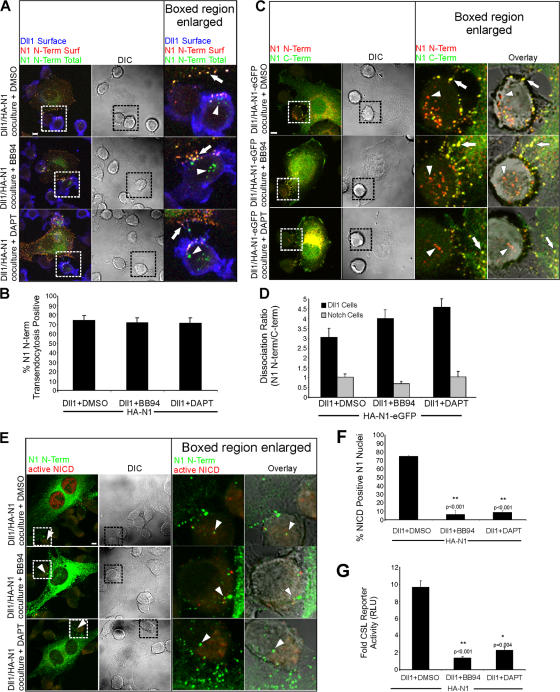Figure 5.
Notch1 transendocytosis and N-terminal dissociation does not require cleavage by ADAM or γ-secretase. (A) Dll1 cells were cocultured with HA-N1 cells in the presence of vehicle control (DMSO), ADAM inhibitor (BB94), or γ-secretase inhibitor (DAPT). Cocultures were treated as in Fig. 2 (A and C) to identify surface Dll1 (blue), surface N1 N terminus (red), and total N1 N terminus (green). Arrows indicate N1 N terminus on the surface of the Notch cells (yellow). Arrowheads indicate N1 N terminus detected within Dll1 cells (green). (B) Transendocytosis was quantified as in Fig. 2 D. (C) Dll1 cells were cocultured with HA-N1-EGFP cells in the presence of DMSO, BB94, or DAPT, as in Fig. 4 A, to identify N1 N terminus (red) and N1 C terminus (green). Arrows indicate double-positive N1 clusters (yellow); arrowheads denote vesicular structures positive for only N1 N terminus (red). (D) Dissociation ratios were quantified for both Dll1 and Notch cells, as in Fig. 4 B. (E) Dll1 cells were cocultured with HA-N1 cells in the presence of DMSO, BB94, or DAPT, as in Fig. 3 A, to identify N1 N terminus (green) and activated NICD (red). Arrowheads indicate N1 N terminus within Dll1 cells interacting with N1 cells. (F) NICD-positive nuclei were scored as in Fig. 3 B. (G) CSL reporter assay in the presence of DMSO, BB94, or DAPT as in Fig. 3 C. Cocultures in (A, C, and E) were imaged by confocal and DIC microscopy. Boxes indicate enlarged regions. Overlays are composites of fluorescent and DIC images. Error bars represent the SEM (B, D, and F) and the SD (G). *, P < 0.05; **, P < 0.001; t test relative to DMSO controls. Images from each experiment were uniformly adjusted using the levels function in Photoshop. Bars, 5 μm.

